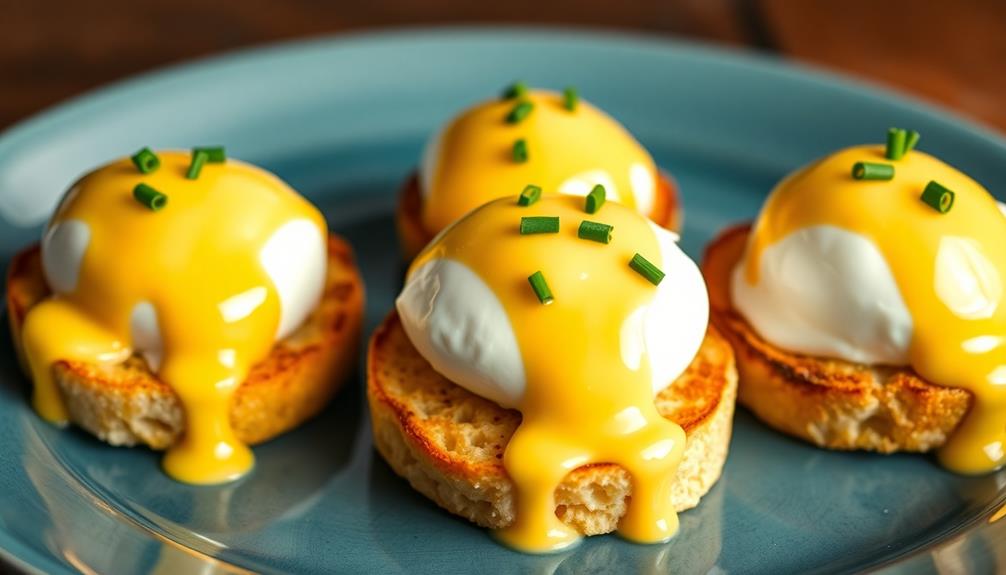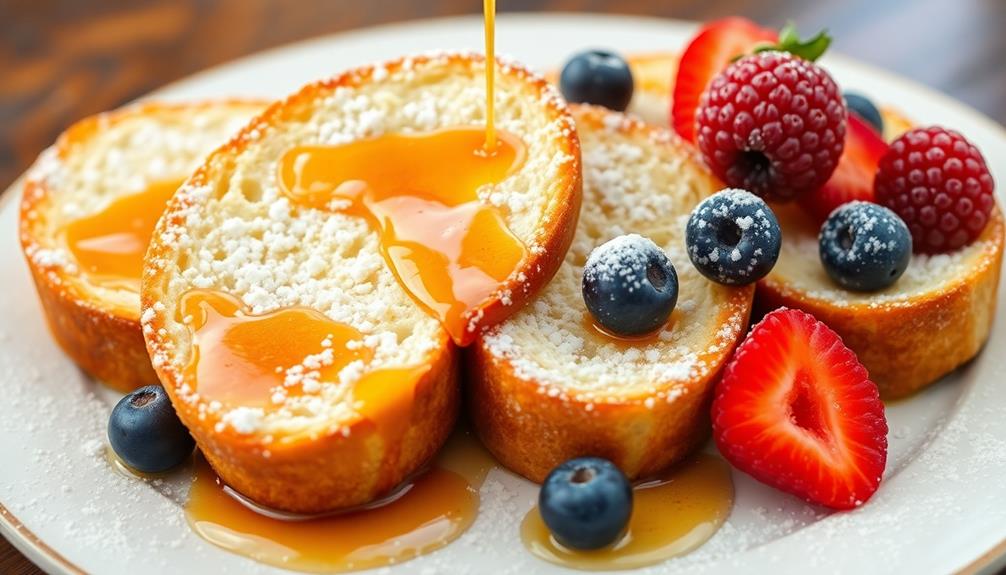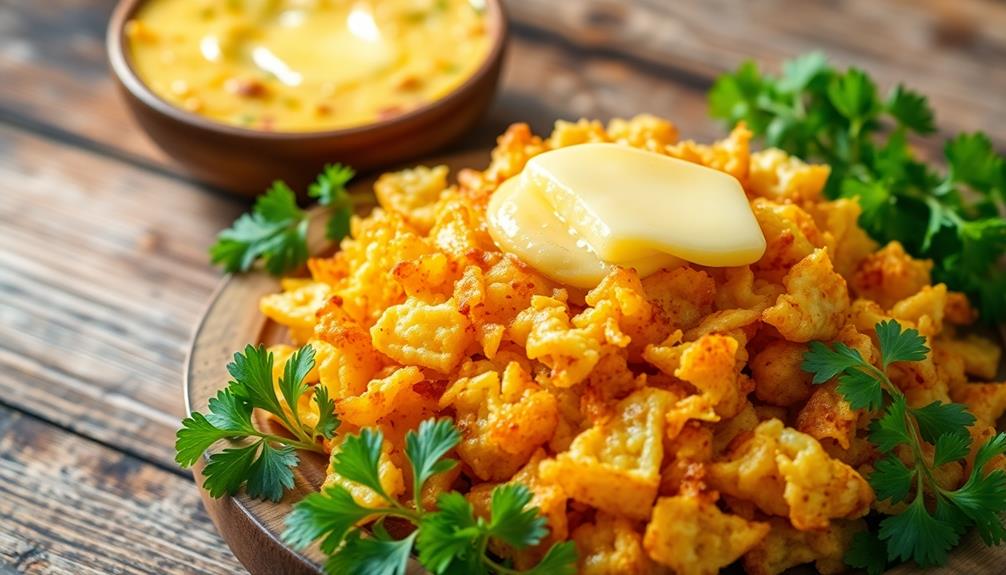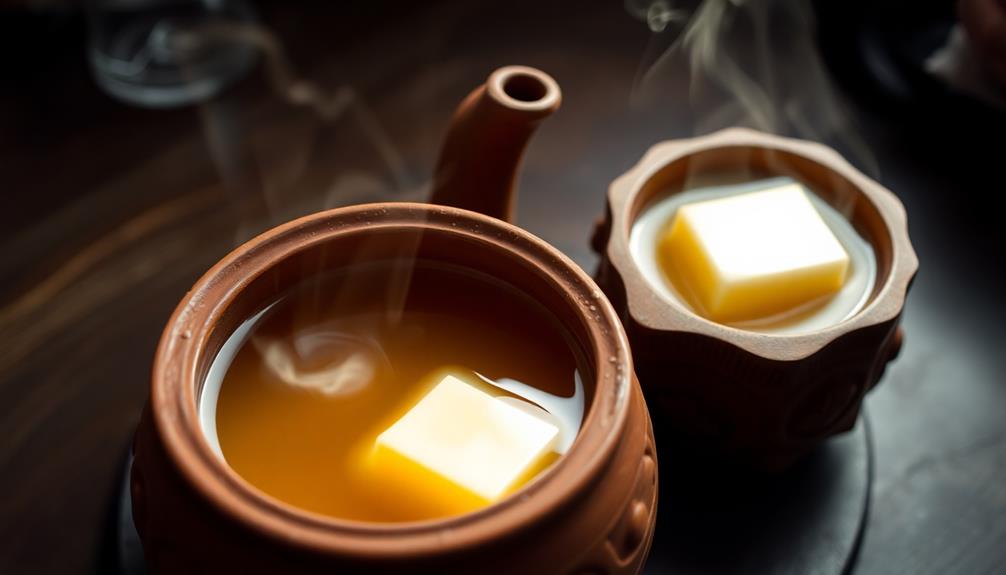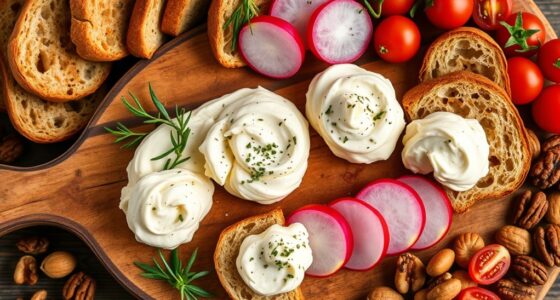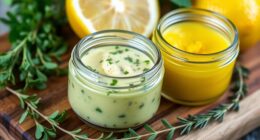If you're craving an indulgent and show-stopping breakfast, you've got to try the classic Butter-Poached Eggs Benedict. This decadent dish combines a rich, velvety hollandaise sauce, tender Canadian bacon, and perfectly poached eggs nestled atop toasted English muffins for a flavor explosion in every bite. The history of this iconic breakfast dates back to late 19th century New York City, where it was first created at the Waldorf Hotel. With simple yet carefully executed cooking techniques, you'll achieve the ultimate in breakfast luxury. Keep reading to uncover the step-by-step guide for making this breakfast masterpiece at home.
Key Takeaways
- Butter-Poached Eggs Benedict is a rich and indulgent breakfast dish featuring poached eggs, Canadian bacon, and creamy hollandaise sauce on toasted English muffins.
- The dish's origins can be traced back to late 19th century New York City, with variations that have evolved over time.
- The key cooking techniques for this recipe include butter-poaching the eggs, carefully emulsifying the hollandaise sauce, and toasting the English muffins to create a contrast in textures.
- The flavor profile of Butter-Poached Eggs Benedict is a harmonious balance of richness, acidity, and savory elements, with each component complementing the others.
- Butter-Poached Eggs Benedict is an impressive and memorable breakfast dish, perfect for special occasions or weekend brunches, and can be elevated further with thoughtful presentation and accompaniments.
History
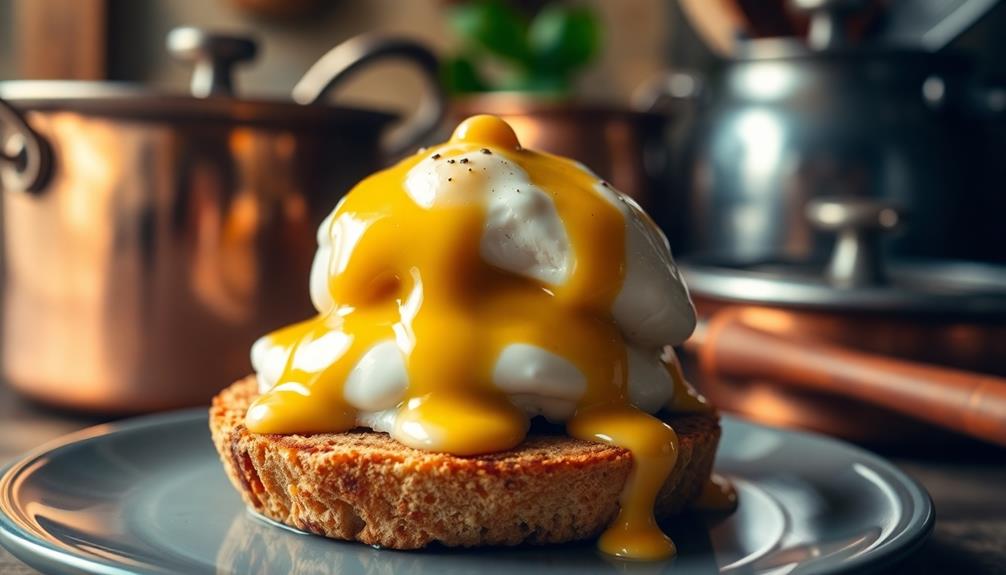
Although the origins of Eggs Benedict are murky, it's believed the dish was first created in the late 19th century in New York City. The story goes that a hungover Wall Street broker named Lemuel Benedict stumbled into the Waldorf Hotel and asked for "some buttered toast, poached eggs, crisp bacon, and a hooker of hollandaise."
The hotel's maître d'hôtel, Oscar Tschirky, was so impressed by the combination that he added it to the menu, substituting the bacon for Canadian bacon and the toast for an English muffin.
Over time, the dish evolved, with variations including the use of ham, spinach, or even crab meat.
But the classic Eggs Benedict – a toasted English muffin topped with Canadian bacon, a perfectly poached egg, and a rich, creamy hollandaise sauce – remains a beloved breakfast and brunch staple.
Its luxurious flavors and velvety texture have made it a favorite among both casual diners and culinary connoisseurs alike.
Recipe
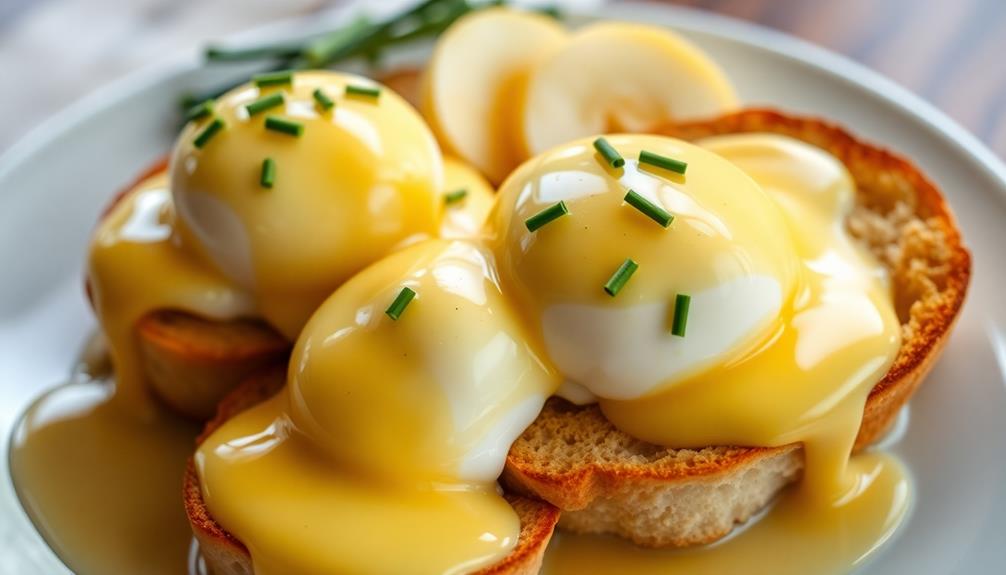
Butter-poached eggs benedict is a luxurious and indulgent breakfast dish that combines the richness of poached eggs with the velvety texture of hollandaise sauce. This recipe elevates the classic eggs benedict with the addition of butter-poached eggs, creating a truly decadent experience.
The key to this dish lies in the careful poaching of the eggs in a bath of melted butter. This gentle cooking method results in eggs with a silky, custard-like interior and a delicate, runny yolk that pairs perfectly with the toasted English muffin and the creamy hollandaise sauce.
Ingredients:
- 4 eggs
- 1/2 cup unsalted butter, melted
- 2 English muffins, split in half
- 4 slices Canadian bacon
- Hollandaise sauce (store-bought or homemade)
- 1 tablespoon white vinegar
- Salt and freshly ground black pepper, to taste
Instructions:
Gently bring a saucepan of water to a gentle simmer over medium heat. Add the white vinegar to the water. Crack each egg into a small ramekin or cup. Carefully lower the ramekins into the simmering water and poach the eggs for 4-5 minutes, or until the whites are set and the yolks are still runny. Remove the poached eggs from the water using a slotted spoon and set aside.
In a separate saucepan, melt the butter over low heat. Once melted, reduce the heat to the lowest setting to keep the butter warm and liquid. Gently lower the poached eggs into the melted butter and let them sit for 2-3 minutes, basting them with the butter occasionally.
Toast the English muffin halves until golden brown. Top each muffin half with a slice of Canadian bacon, a butter-poached egg, and a generous drizzle of hollandaise sauce. Season with salt and pepper to taste.
For best results, serve the butter-poached eggs benedict immediately, while the eggs are still warm and the yolks are runny. The combination of the silky, butter-poached eggs, the crisp English muffin, the savory Canadian bacon, and the rich hollandaise sauce creates a truly indulgent and memorable breakfast experience.
Cooking Steps
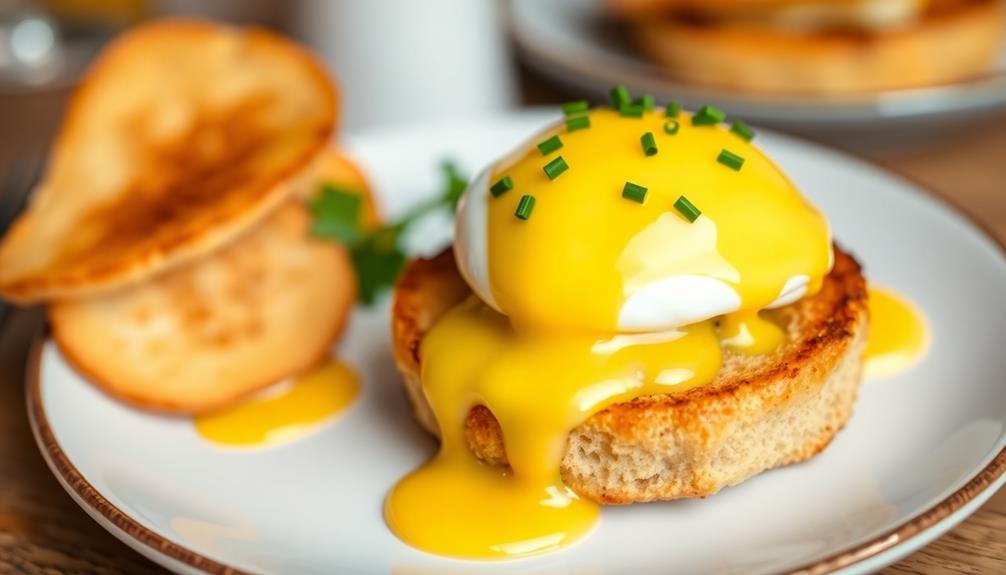
First, you'll want to poach your eggs in a butter-infused water bath for a rich, velvety texture, which is enhanced by the creamy characteristics of butter that make it a staple in many culinary applications.
Be sure to use butter's unique properties to create a luscious base for your dish.
Next, whip up a smooth and creamy hollandaise sauce to drizzle over the top.
Step 1. Poach Eggs in Butter-Infused Water
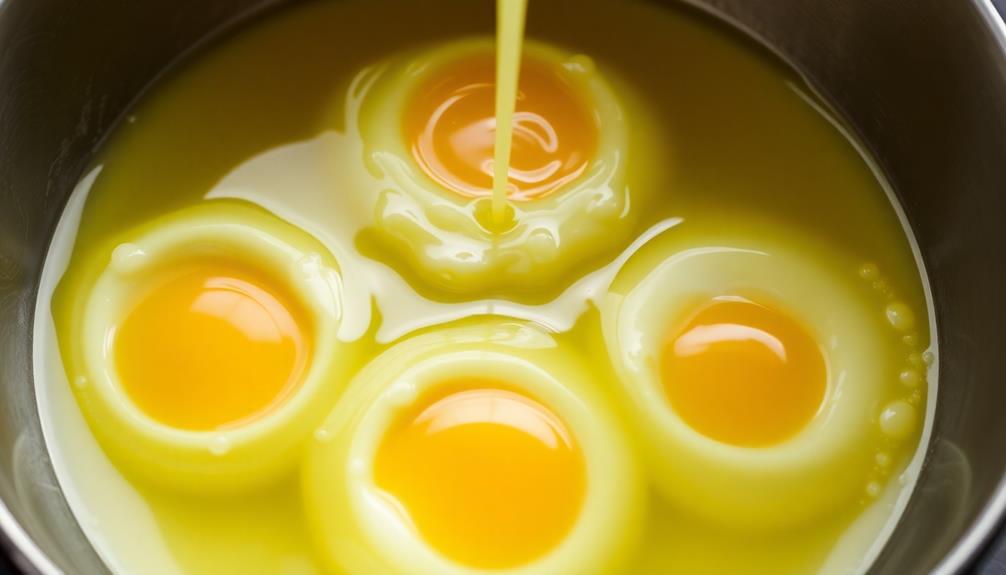
To poach the eggs in the butter-infused water, bring a large saucepan filled with water to a gentle simmer over medium heat.
Once the water is barely bubbling, reduce the heat to low.
Gently crack each egg into a small bowl or ramekin.
Slowly and carefully slide the eggs from the bowl into the simmering water, one by one.
Poach the eggs for 4-5 minutes, until the whites are set, and the yolks are still runny.
Use a slotted spoon to gently lift the poached eggs from the water, letting any excess water drip off.
The butter-infused water will give the eggs a rich, velvety texture and flavor.
Serve the poached eggs immediately, either on top of the toasted English muffins or on their own, savoring the delicate balance of the soft egg yolks and the luxurious butter notes.
Step 2. Make Hollandaise Sauce

Next, prepare the hollandaise sauce. In a medium bowl, whisk together 3 egg yolks, 2 tablespoons of lemon juice, and a pinch of salt until the mixture is smooth and creamy.
It's important to focus on maintaining a stable temperature while cooking, much like how understanding IRA Inheritance Rules can help avoid costly errors in your financial planning.
Place the bowl over a saucepan of simmering water, making sure the bowl doesn't touch the water. Slowly drizzle in 1/2 cup of melted butter, whisking continuously, until the sauce thickens and emulsifies.
If the sauce becomes too thick, add a tablespoon of warm water to thin it out. The hollandaise should have a rich, velvety texture.
Remove the bowl from the heat and keep the sauce warm until you're ready to assemble your Eggs Benedict.
The creamy, tangy hollandaise complements the buttery poached eggs perfectly, elevating this indulgent breakfast dish to new heights.
Step 3. Toast English Muffins
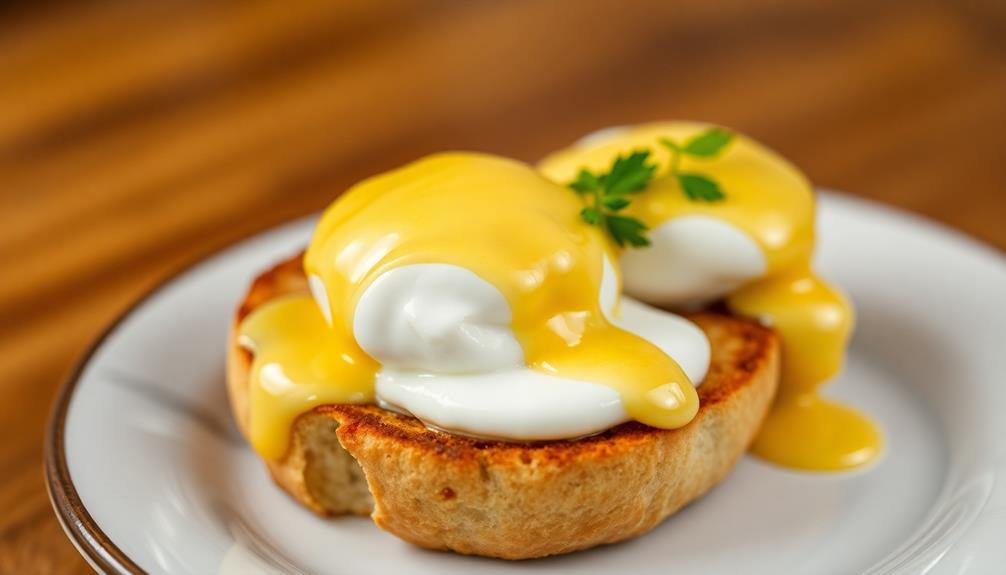
Fire up your toaster or toaster oven to get the English muffins nicely browned.
You'll want them crisp and golden on the outside, while still tender and fluffy on the inside. Carefully place the muffin halves in the heated appliance and let them toast until they reach your desired level of doneness.
Keep a close eye on them, as toasting times can vary. Once they're perfectly toasted, remove the muffins and set them aside.
You'll want them warm and ready to go when it's time to assemble your Eggs Benedict. The crunchy texture of the toasted muffins provides the perfect base for the creamy hollandaise and silky poached eggs.
Don't be afraid to get a little creative and experiment with different types of muffins too – whole wheat or sourdough would also work beautifully in this dish.
Just make sure they're nicely toasted and ready to soak up all that delicious flavor.
Step 4. Assemble Benedict and Garnish
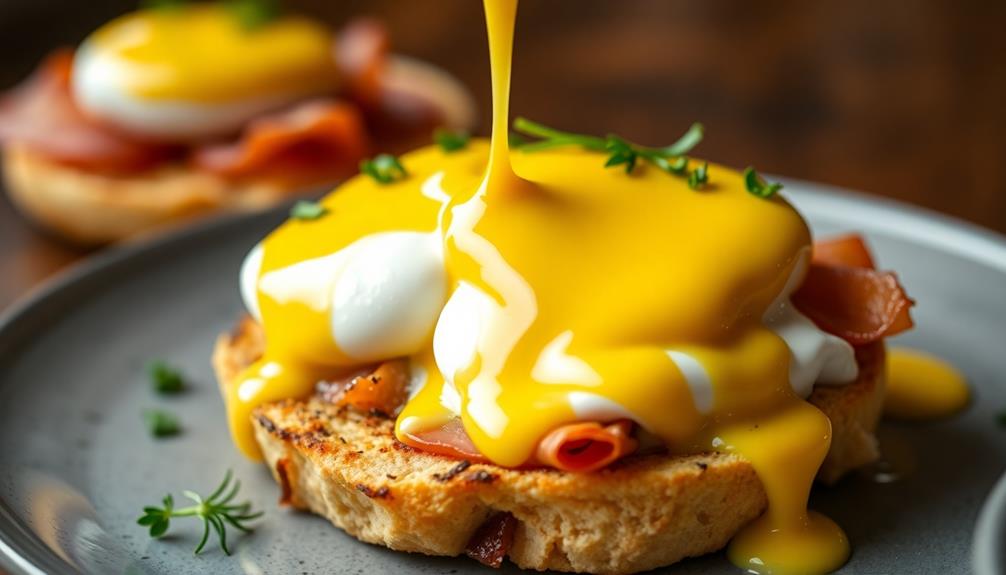
Assembling the Eggs Benedict is the next crucial step.
First, place a toasted English muffin half on each plate. Top each muffin with a slice of savory Canadian bacon.
Now, the star of the show – the perfectly poached eggs. Gently place one egg atop the Canadian bacon on each muffin half.
Next, it's time for the luxurious butter sauce. Drizzle the velvety hollandaise sauce over the eggs, allowing it to cascade down the sides. The rich, creamy sauce complements the runny yolks beautifully.
To finish, sprinkle a pinch of freshly ground black pepper over the top. The contrast of the peppery kick against the buttery smoothness is simply divine.
Step 5. Drizzle Hollandaise Over Assembled Benedict
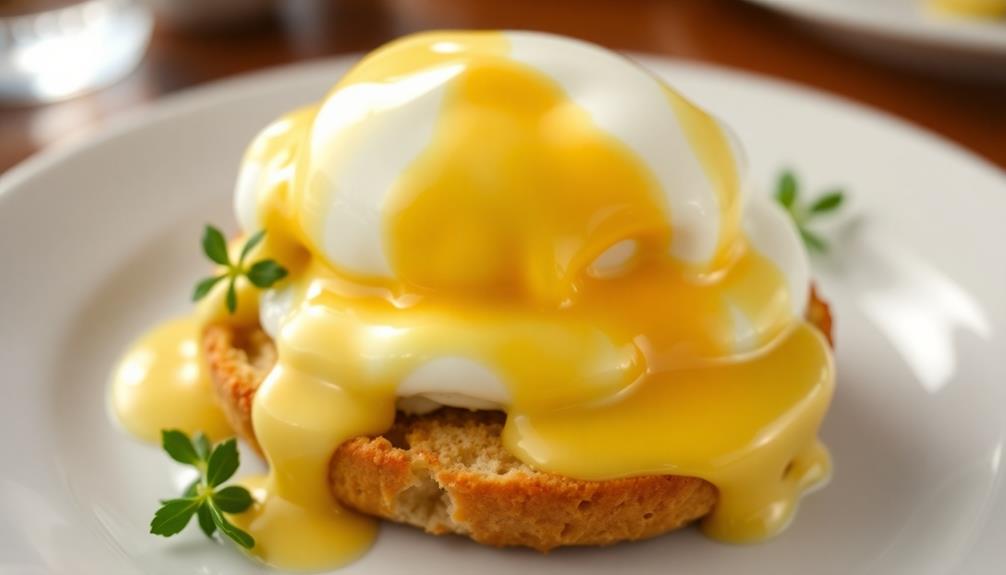
Now that the Eggs Benedict is assembled, it's time to drizzle the hollandaise sauce over the top. You'll want to work quickly, as the sauce can cool and thicken if left sitting.
For an even richer flavor, consider using higher fat content butter in your hollandaise, as it enhances the luxurious texture. Gently spoon the creamy, golden hollandaise over each stack, allowing it to gracefully cascade down the sides.
Make sure to get an even coating on the English muffin, ham, and perfectly poached egg. The velvety hollandaise will add a luxurious richness to the dish, complementing the buttery flavors.
As you drizzle, picture the sauce glistening and reflecting the light, enticing you to take that first bite. Don't be stingy – go ahead and generously sauce each serving.
The hollandaise is the crowning glory, tying all the elements of this decadent Eggs Benedict together. With the final touches complete, your masterpiece is ready to be devoured.
Get ready for an explosion of flavors in every heavenly forkful.
Final Thoughts
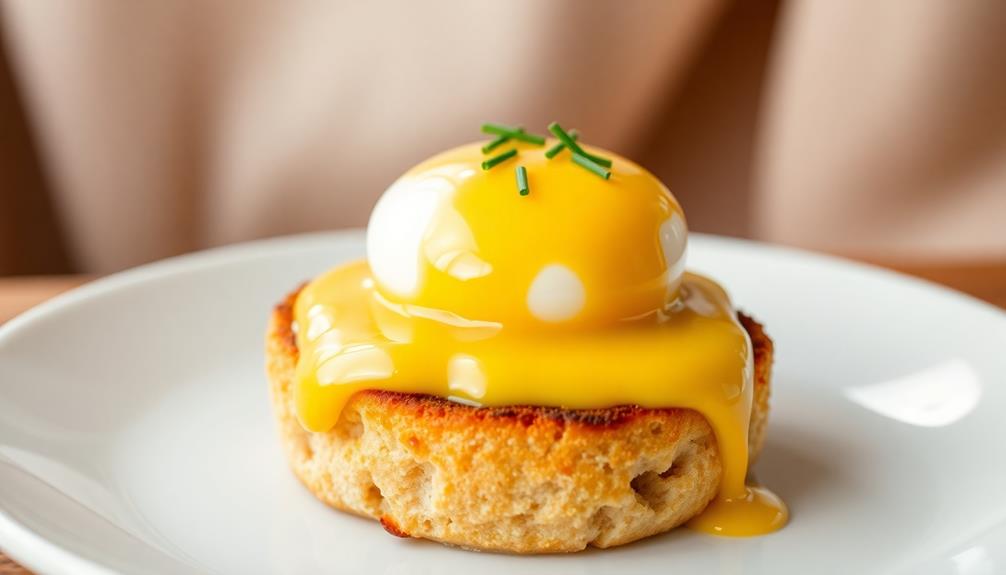
With a delectable Butter-Poached Eggs Benedict now complete, you can confidently serve this indulgent dish to your guests. The rich, velvety hollandaise sauce draped over the perfectly poached eggs and Canadian bacon atop a toasted English muffin is truly a breakfast fit for royalty.
The butter-poaching technique elevates the eggs, making them exceptionally tender and flavorful. This recipe is a labor of love, but the end result is well worth the effort. Your guests will be delighted by the luxurious textures and flavors that dance on their palates.
Impress them with your culinary prowess and enjoy the satisfied smiles as they savor each bite. With just the right balance of richness and acidity, this Butter-Poached Eggs Benedict is a showstopping breakfast that will have your loved ones asking for seconds.
Indulge in this decadent treat and create lasting memories around the table.
Frequently Asked Questions
Is the Butter-Poached Egg Easier to Prepare Than a Regular Poached Egg?
Compared to a regular poached egg, butter-poached eggs can be trickier to prepare. The process of slowly poaching the egg in butter takes more time and attention, but the result is a richer, more luxurious texture.
Can I Use a Different Type of Cheese Instead of Hollandaise?
Yes, you can use a different type of cheese instead of hollandaise. Try cheddar, swiss, or even a sprinkling of parmesan for a unique twist on the classic Eggs Benedict.
How Do I Ensure the Eggs Don't Overcook in the Butter?
To ensure the eggs don't overcook in the butter, gently lower them into the warm butter and monitor their doneness closely. Remove them as soon as the whites are set but the yolks are still runny.
Can I Make the Hollandaise Sauce Ahead of Time?
Yes, you can make the hollandaise sauce ahead of time. It'll keep in the fridge for up to 3 days. Just reheat it gently before serving to ensure a creamy, silky texture. This makes prepping the dish a breeze.
Is This Recipe Suitable for a Large Group or Just for One?
This recipe is suitable for serving a large group, not just one person. You can easily scale up the ingredients to accommodate more guests, making it a great choice for a brunch or breakfast gathering.
